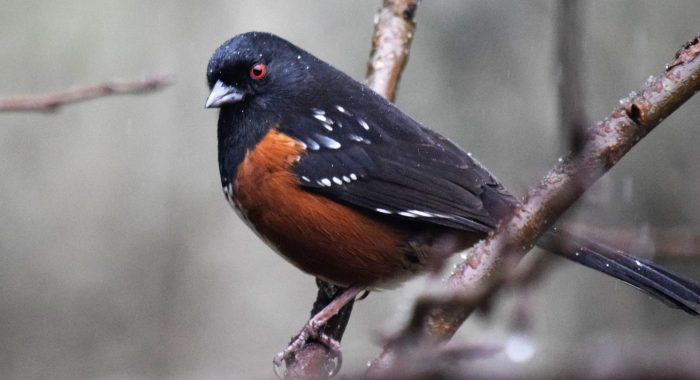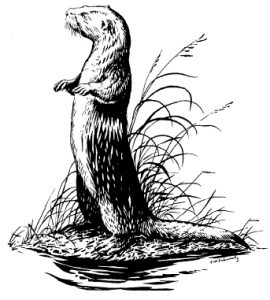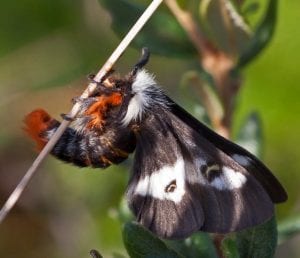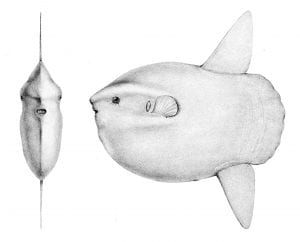By John L. Turner

I slung on the backpack, shut the car door and walked off quickly, fueled by excitement and expectation. After a brisk walk on a shady forest path, bordered by a few small fields hinting at the property’s past farm use, I reached my destination — a wooden observation platform providing sweeping views of a freshwater pond situated within the North Fork’s Arshamomaque Preserve. I immediately began a binocular scan of the water and the far shore for any sign of movement revealing their presence. Nothing. Scanned for a few more minutes and nothing. I soon fall into a pattern of picking up the binoculars and looking first along the water surface and then the vegetated far shore. This goes on for an hour. Still no action.
I learned a long time ago that nature is not a zoo and the comings and goings of animals are never done to please us humans, but always in response to their needs. So I will see them, if I see them at all, on their schedule. I continue to patiently sit, soaking in the beauty of the warm sunshine, bolstered by a large cup of strong coffee and a cinnamon-raisin bagel.
I was also enjoying the many marsh mallow shrubs blooming in profusion amidst the abundance of cattails ringing the pond. The flowers of this species border on the spectacular — three to five inches across, deep but bright pink petals with a red throat or base, and a prominent tower containing both the stamens and the stigmata. This species is related to the plant whose roots were once the source of that delicious confectioneries used to make s’mores — marshmallows.
Suddenly, there was rippled movement along the far shore. It took me a moment to process what I was looking at but it was a family of four river otters (Lontra canadensis) — two adults and two pups — weaving in and out of the wetland plants. I enjoyed them for about 15 seconds until they all broke back into cover of the cattails at the eastern edge of the pond. A minute or two later they reappeared this time swimming along the wooded shoreline before doubling back to the cattails.
What I was witnessing is a small part of a welcome recovery of the species taking place over several decades now, as an increasing number of otters are colonizing suitable wetland habitat on Long Island, after decades of their dearth. According to Paul Connor’s definitive Mammals of Long Island published by the New York State Museum in 1971, otters were thought to be extirpated from Long Island in the latter part of the 19th century. He states that Daniel Denton in his 1670 description of Long Island mammals noted the presence of otters, but goes on to mention that more than 170 years later J.E. DeKay declared the species extirpated from Long Island.
Through the 20th century otters were occasionally seen or reported but there was no sense of a sustained recovery of the species on Long Island. Connor reports no sightings in all the field work (conducted over several field seasons in the late 1960’s) that formed the basis for his monograph. This began to change in the first few years of the 21st century when sightings of otters became more commonplace. One of the first sightings was near the well-known Shu Swamp sanctuary in Mill Neck, Nassau County.
Mike Bottini, a well-known Long Island naturalist and founder of the Long Island River Otter Project, has studied this recovery as well as other aspects of otter ecology and biology and published an informative published paper investigating the status of river otter in 2008. He states: “This survey estimates that there are at least eight river otters inhabiting Long Island: four on the north shore of Nassau County, one in the Nissequogue River watershed, one in the west end of the Peconic Estuary, one on the south shore, and one in the Southold-Shelter Island-East Hampton area.” Remarkably, a mere decade later otter signs were found in 26 watersheds; the recovery was well underway.
Three years later, in 2021, Mike noted: “otter home ranges included all the watersheds on the north shore from Oyster Bay east to Orient, the Peconic River watershed and a significant portion of the Peconic Estuary, and two watersheds on the south shore.” Painting a rosy picture, Mike concludes: “Much excellent otter habitat on Long Island remains unoccupied, especially on the south shore.
In addition to the obvious confirmation formed by actual sightings or finding their tracks in mud or snow, the use of latrines or “otter bathrooms” by this highly aquatic mammal is one of the ways researchers use to gain a better sense of their distribution on Long Island. For reasons that are not entirely clear, otters often defecate (known as scat) in upland areas adjacent to the waterways, these latrine sites thought to be used to communicate information.
I have found their latrines in a few places, the closest being at Frank Melville Memorial Park in Setauket on both sides of the northern pond. Their scat often contains the remains of scales and bones of the fish they prey on, and such was the case by a recent inspection of the latrines at the park — scales and delicate fish bones were prevalent in the sushi meals the otter was consuming. While otters favor fish, they are opportunistic and will eat frogs, turtles, crayfish (yes, we do have crayfish species on Long Island), and freshwater clams and mussels.
Otters are carnivores and are members of the weasel family whose other Long Island members include, according to Connor, Mink, Long-tailed weasel, and perhaps Short-tailed weasel. Further afield in the North American continent we have badgers, the federally endangered Black-footed ferret, and the famous and remarkable wolverine. Thirteen otter species occur around the globe.
As evidenced by my North Fork experience and several other accounts, otters are reproducing on Long Island with their pups presumably helping to fuel the resurgence. As their young (typically between 2-5 pups are born) are quite helpless at birth, being hairless and blind, they grow and develop in dens which provide some degree of protection from the elements. The dens are in close proximity to the water and may, in some cases, be connected to it. As of this writing I don’t know of anyone who has conclusively discovered an otter den here.
The use of remote cameras installed in the field at sites likely to be utilized by otters have proven instrumental in learning some new streams and creeks otters are frequenting. Luke Ormand, a staff member in the Town of Brookhaven’s Division of Land Management, has placed several cameras in numerous locations in Brookhaven Town that have been successful in recording otters. With these cameras, otters have been confirmed in the Carmans River watershed and the Motts Creek drainage system in Bellport.
A significant damper on the continued recolonization and expansion of river otters on Long Island are motor vehicles, as otters are sometimes struck and killed. An otter was recently struck on Jericho Turnpike near the famous bull statue in Smithtown and the total number of road killed otters recorded for Long Island stands at 29 animals.
Bottini notes that the peak time is between March and May both when males are searching for females in estrus (ready to mate) and yearling individuals are striking out on their own. The likelihood of being hit by a vehicle is especially high in places where otters are forced to cross a road that spans a stream containing too narrow a culvert or a dam where the dam is under the bridge; the dam face prevents downstream or upstream access, forcing the otter to climb up the banks and lope across the dangerous roadway. Solutions involve the placement of stacked cinder blocks to form a ramp or aluminum ramps which otters can negotiate.
I had the pleasure of working with the aforementioned Mike and Luke one day a few years ago in constructing a cinder block ramp along a dam face on the Little Seatuck Creek in East Moriches. Camera footage soon showed otter use of the ramp although the two otters in the area illustrated different personalities; one otter immediately took to using it while the other was quite hesitant.
Mike notes that otters are “ambassadors of wetlands” and given their broad appeal and popularity this is true. Who doesn’t remember wildlife films on Disney and other shows depicting otters tobogganing in the snow, frolicking about in what appears to be joyous play? Perhaps this iconic and charismatic species can help to generate public support on Long Island in better protecting our waterways — important habitats — which sustain so many species.
Let me end by stating the obvious: you “otter” take time out of your busy schedule to look for these furry, very attractive ambassadors. But please drive slowly to your intended destination, all the while keeping an eye out for a sleek, rich brown animal loping across the road.
A resident of Setauket, author John L. Turner is conservation chair of the Four Harbors Audubon Society, author of “Exploring the Other Island: A Seasonal Nature Guide to Long Island” and president of Alula Birding & Natural History Tours.



 For example, two scientists discussing otter biology need to know what otter species they’re talking about. Is it the Sea Otter (Enhydra lutris)? Or maybe the River Otter (Lontra canadensis) or Asian Small-clawed Otter (Aonyx cinereus)? How about Giant River Otter, (Pteronura brasiliensis), European Otter (Lutra lutra) or any other of the thirteen species of otters found in the world. In discussing some aspect of otter ecology or biology, just mentioning “otter” may not be sufficient to provide the level of specificity or accuracy needed. Researchers need to know they’re both talking about the same species of otter. Or bacteria. Or slime mold. Or many other species that can affect us.
For example, two scientists discussing otter biology need to know what otter species they’re talking about. Is it the Sea Otter (Enhydra lutris)? Or maybe the River Otter (Lontra canadensis) or Asian Small-clawed Otter (Aonyx cinereus)? How about Giant River Otter, (Pteronura brasiliensis), European Otter (Lutra lutra) or any other of the thirteen species of otters found in the world. In discussing some aspect of otter ecology or biology, just mentioning “otter” may not be sufficient to provide the level of specificity or accuracy needed. Researchers need to know they’re both talking about the same species of otter. Or bacteria. Or slime mold. Or many other species that can affect us.





